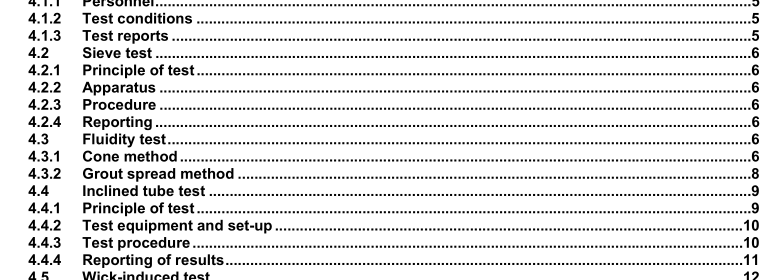EN 445:2007 – Grout for prestressing tendons – Test methods

1 Scope
This European Standard describes the test methods for grout specified in EN 447. Testing shall be performed in accordance with the test methods given in this standard (reference test methods). The test methods are applicable to grout for all types of structures including bridges and buildings.
2 Normative references
The following referenced documents are indispensable for the application of this document. For dated references, only the edition cited applies. For undated references, the latest edition of the referenceddocument (including any amendments) applies.
EN 196-1, Methods of testing cement – Determination of strength
EN 447, Grout for prestressing tendons – Basic Requirements
3 Terms and definitions
For the purposes of this document, the following terms and definitions apply.
3.1
grout
homogeneous mixture of cement and water, it may contain admixtures and additions
4 The testing of grout
4.1 General
4.1.1 Personnel
The grouts shall be tested by competent personnel experienced in the subject.
4.1.2 Test conditions
Testing shall be carried out at specified temperatures.
The grout for the tests shall be made from materials specified in EN 447 and mixed in accordance with EN 447.
NOTE EN 446 requires suitability testing to be carried out using the same type of mixing equipment as is used for the actual site operations, hence it is preferable to also use the same type of equipment for all testing.
4.1.3 Test reports
All test reports shall include the following information as a minimum:
a) reference to this European Standard;
b) name and address of the testing laboratory;
c) identification number of the test report;
d) name and address of the organisation or person who ordered the test;
e) name and address of the manufacturer or supplier of the product(s);
f) name or other identification mark of the product;
g) date of fabrication, and if relevant, supply of the product;
h) date of manufacture of test specimens;
i) date of test;
j) temperature of the fresh grout and ambient temperature;
k) batching and mixing procedures used;
l) specification of the grout mixer used;
m) identification of test equipment used, including where appropriate, calibration details;
n) individual results for the required test;
o) any inaccuracies or uncertainty of test results;
p) date and signature of the person responsible for the tests.
4.2 Sieve test
4.2.1 Principle of test
The test consists of pouring a quantity of grout through a sieve to check for the absence of lumps on the sieve
4.2.2 Apparatus
A 150 mm diameter sieve with an aperture ≤ 2 mm.
4.2.3 Procedure
Pour a minimum of 1 l of freshly mixed grout through the sieve.
NOTE This may be carried out while filling the fluidity test cone.
4.2.4 Reporting
Report the absence of lumps on the sieve.
4.3 Fluidity test
NOTE Two test methods are described, only one is to be performed as appropriate for the type or characteristics of the grout.
4.3.1 Cone method
4.3.1.1 Principle of test
The fluidity of grout, expressed in seconds, is measured by the time necessary for a stated quantity of grout (1 l) to pass through the orifice of the cone, under stated conditions.
EN 445:2007 – Grout for prestressing tendons – Test methods